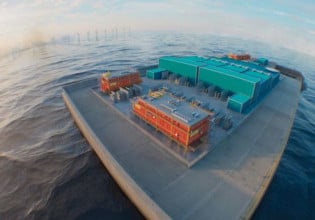A co-founder of ARDA Power, Inc., Luis E. Zubieta, presented a paper titled "Power Management and Optimization Concept for DC Microgrids" at this week's 2015 International Conference on DC Microgrids in Atlanta, Georgia. Dr. Zubieta, opened his presentation stating, "It is proposed that the energy storage system always controls the dc bus voltage independently of the microgrid mode of operation and sets its value based on power and energy management rules to activate responses from the other components. The proposed concept will eliminate time critical control mode changes resulting from grid disturbances or energy management conditions. Furthermore, the concept enables the use of individual and flexible generation and consumption patterns for each component in the microgrid that can be set to minimize the operating cost of the installation.
He continued, “DC microgrids able to operate as grid connected or grid independent have been conceived operating in completely different modes depending on the availability of the grid and the State of Charge (SOC) for the energy storage system (ESS). The transfer between these modes introduces additional complexity and reduces the system reliability. As more functionality is provided by the ESS and its size is minimized to reduce cost, the energy management becomes critical and additional compromises have to be reached between the different sources, loads, and functionalities. This requires fast and reliable communication amongst the different control components forming the microgrid. In addition, as larger dc microgrids are conceived using different types of resources, minimizing the operating cost of the installation is fundamental for the economic viability of the concept.
“Our proposal consists of a power and energy management concept where the dc bus voltage is used as the only mean of communication amongst components connected to the microgrid. In the proposed power management, the dc voltage control is always carried out by the ESS following an algorithm that changes the voltage slightly with respect to the nominal dc bus voltage.
“In this control method, the algorithm used to set the dc bus voltage takes in account the State of Charge for the energy storage system and it could also consider other variables such as the ESS power and statistical loading patterns. All the sources and loads connected to the microgrid use the dc bus voltage to modify their power production or consumption in order to keep the ESS operating within its specified limits and to ensure that the microgrid satisfy other performance requirements. The way each source or load responds to changes in dc bus voltage would depend on its particular operating requirements and may also depend on other factors such as the time of the day, the season of the year, and its operating cost.
“Despite the benefits of using the dc bus voltage to change operating modes of the microgrid components, it is possible to simplify the controls and obtain more benefits from this concept. In island mode, it is logical to use the ESS to control the dc bus voltage since the ESS is the power balancing element and the energy management is ultimately run in the ESS controller. Even if the ESS is operating at very high or very low state of charge, it can be used to maintain the dc link in such a way to produce a response from sources or loads that avoids full discharge or overcharging of the ESS. The rest of components on the microgrid always operate as power sources or loads independently of the state of charge for the energy storage system.
“Because the operating mode for the different components on the microgrid does not change, the ESS can now set the dc bus voltage continuously to trigger smooth and sequenced responses from the other components in the microgrid instead of sudden changes. As an example, the state of charge (SOC) could be used to set the dc bus voltage as follows:
• If the SOC is within a specified range, the dc bus voltage is set to the nominal value.
• For SOC values higher that a preset limit, the ESS would set the dc bus voltage to values higher that nominal depending on the SOC to indicate that the power production needs to be reduced: the higher the SOC the higher the dc bus voltage.
• If the SOC reaches critically high values, the ESS would trigger a controller that increases the dc bus voltage to reduce the charging power so that the ESS does not get overcharged.
• For SOC values lower that a preset limit, the ESS would set the dc bus voltage to values lower than nominal depending on the SOC to indicate that the load needs to be reduced.
• If the SOC reaches critically low values, the ESS would trigger a controller that changes the lowers the dc bus voltage to reduce the discharge power so that the ESS is not fully discharged.
“Classical communication means critical to the operation reduce the reliability of the microgrid. Changes of operating mode including switching the dc voltage control function amongst components is unnecessary and a potential cause for miss operation and instability. In our proposed power management system the energy storage system always controls the dc bus and changes its value to send information to other components in the microgrid. The concept has been validated by simulations and experimentally. Furthermore, this concept is also open the possibility of plug and play incorporation of resources and loads in the dc microgrid and the optimization,†Zubieta concluded.






